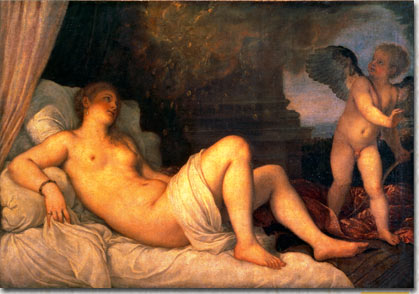|
|
 |

By the year 1500, Venice had developed its own artistic style which differed from that of Florence and Rome. There was intense rivalry between these two styles, expressed in the so-called disegno vs. colorito debate—which asked whether draughtmanship or the use of color was of greater importance in painting. Titian, as the greatest colorist ever, epitomized the Venetian command of color, using in his Danaë, not many different colors but color as a single element, unifying the painting and binding it together. Vasari, in his Lives of the Artists, relates how Titian met his rival from Florence, Michelangelo, when Titian delivered his Danaë to its new owner in Rome. Michelangelo praised the painting's colorito but criticized its designo (the faulty left leg).
 |
| Danaë, Titian |
 |
Various reasons are given for the Venetians' command of color. As the greatest maritime power in Europe, at the center of trade between north and south and east and west, Venice was the port-of-entry for all exotic pigments and dyes and Venetian artists used these extravagantly. Oil paints allowed more subtle coloring effects and were adopted early by Venetian artists, probably because tempera and fresco were unstable in the humid sea air of Venice. Finally, Venice is uniquely situated in a lagoon. Light over water—falling from every direction in a lagoon—produces dramatic optical effects and these may well have heightened the sensitivity of Venetian artists to color.
< Previous Next >
|



